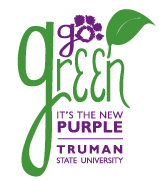 Toward Carbon Neutrality
Toward Carbon Neutrality
The President’s Sustainability Action Committee has been working on a detailed proposal for the President that outlines a strategy for achieving carbon neutrality by the year 2050.
This proposal recommends that Truman reduce its emissions by 50% by the year 2030, and achieve full carbon neutrality by 2050.
The strategy below outlines the draft proposal for how Truman can plan, implement and measure its progress toward carbon neutrality.
Sustainability 2.0 – High-level Overview of the Proposed Plan
- Utilize our AASHE membership to take advantage of resources, benchmarking tools, and partnerships.
- Complete the STARS Survey and utilize the SIMAP tools to measure our progress on an annual basis.
- Join the Climate Leadership Network and consider signing a formal Carbon Commitment (focused on reducing greenhouse gases).
| Utilize our AASHE membership to take advantage of resources, benchmarking tools, and partnerships.
Continue to utilize our AASHE (Advancing Sustainability in Higher Education) membership to stay involved in overall issues promoting sustainability on campus. Since 2005, AASHE has been guiding higher education institutions in their efforts to build and support a thriving, equitable and ecologically healthy world. This organization provides a resource hub, benchmarking tools (STARS), training, and vendor partnerships to institutions of higher education. |
|
AASHE – The Association for the Advancement of Sustainability in Higher EducationAASHE empowers higher education faculty, administrators, staff and students to be effective change agents and drivers of sustainability innovation. AASHE enables members to translate information into action by offering essential resources and professional development to a diverse, engaged community of sustainability leaders.
|
| Complete the STARS Survey and utilize the SIMAP tools to measure our progress on an annual basis.
Truman will continue to utilize the STARS tool to measure progress toward our sustainability goals. This will involve the following:
|
|
STARSThe Sustainability Tracking, Assessment & Rating System (STARS) is a transparent, self-reporting framework for colleges and universities to measure their sustainability performance.SIMAP® – Simplifying Sustainability DecisionsSIMAP® is a carbon and nitrogen-accounting platform that can track, analyze, and improve campus-wide sustainability. It includes proven algorithms, based on nearly two decades of work supporting campus inventories with the Campus Carbon Calculator, CarbonMAP and Nitrogen Footprint Tool, and will help create a baseline, benchmark performance, provide reports, set goals, and analyze progress.
|
| Join the Climate Leadership Network and consider signing a formal Carbon Commitment (focused on reducing greenhouse gases). Initially join for a year to ensure this is the best resource for Truman.
Consider joining and utilizing the resources of Second Nature and the Climate Leadership Network to help guide us in our efforts in reducing our carbon emissions.
|
|
Second Nature and the Climate Leadership NetworkThe Climate Leadership Network is comprised of colleges and universities in nearly every state and the District of Columbia who are taking action on climate change and preparing students through research and education to solve the challenges of the 21st century. |